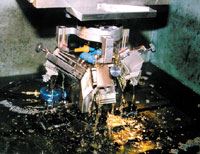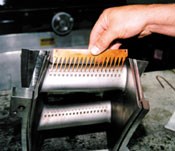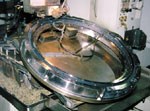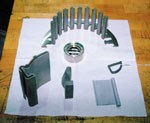Where Wire EDM Is A Workhorse
This shop finds the process practical, productive and predictable, an indispensable technology that supports all of its manufacturing capability.
Share




By its nature, wire EDM (electrical discharge machining) attracts a lot of attention. Using an energized strand of brass wire to slice through difficult-to-machine materials and create intricate profiles and tapers as the wire follows its programmed path is quite remarkable. In the last 25 years, novel and inventive applications for this process have been appearing constantly. At the same time, builders of wire EDM equipment have been constantly improving and speeding up their models. It's no wonder that most discussions of wire EDM gravitate to the latest and greatest.
The message that gets lost is that wire EDM is not just for the extreme or esoteric applications. Wire EDM is a workhorse, too.
Hi-Tek Manufacturing, Inc. in Mason, Ohio, (northeast of Cincinnati) is a good example of wire EDM doing its job, day in and day out, proving to be highly practical, productive and predictable. Wire EDM is an outstanding performer in a shop that depends on outstanding performance from all of its machine tools.
Hi-Tek is a contract machining and precision component manufacturing company. It produces precision components for a variety of industries but has its roots in the aerospace industry. Hi-Tek offers laser cutting; CNC machining and grinding; EDMing; and testing services. Small hole drilling of cooling holes for workpieces in high temperature applications is one of the company's major specialties. In every case, the ability to offer customers a "one-stop advantage" based on combinations of these processes is a key part of the shop's overall strategy.
Deep EDM Roots
The company that became Hi-Tek was originally founded in 1980 as System EDM, Ltd. The founders, Cletis Jackson and Jack Cross, had extensive experience at General Electric's Aircraft Engine Group in Evendale, Ohio, with the use of EDM for drilling airfoil cooling holes. Their expertise in this area helped the young company to become a major supplier of these specialized drilling services as well as allowed it to move into the drilling of fuel injection holes and other fluid flow applications. To this day, work that is related to cooling hole production is a major portion of Hi-Tek's business. More than 60 EDM machines are dedicated to cooling hole work.
In 1985, Gary Griessmann, an associate of Mr. Jackson and Mr. Cross, joined them to start a new business as a sister company to System EDM. This company, named Hi-Tek Manufacturing and located near System EDM's original building, was dedicated to conventional machining as a full-service, high-precision manufacturing facility. Hi-Tek also built tooling and fixturing for its own operations and for its customers on a contract basis. System EDM provided EDMing to Hi-Tek.
In 1990, with the retirement of Jack Cross, Mr. Jackson and Mr. Griessmann decided to consolidate the two companies under the Hi-Tek name and move into a new manufacturing facility constructed near System EDM's original site. At this time, the company acquired new CNC machining centers, CNC slant bed lathes, CNC grinders, and five-axis laser machines.
The new Hi-Tek, however, never lost its focus on EDM as a critical enabling technology. In the mid-1980s, wire EDM had been introduced to enhance the company's growing R&D work for jet engine manufacturers, primarily Pratt & Whitney. Wire EDM proved to be the best way of cutting small intricate components, of doing small detail work, and of fabricating electrode holders for its hole drilling operations.
"Wire machines were slow, not easy to program, and at best could hold a tolerance of a little better than one thousandth," recalls operations manager Scott Stang, who joined the company around that time. "But wirecut soon proved to be so useful for so many projects that it quickly became indispensable."
Today, the shop has nine wire EDM units from several builders, including Brother, Fanuc EDM and Mitsubishi.
With the wire machines fully occupied in support of the complex, high-precision, difficult-to-machine aerospace projects that Hi-Tek was known for, the company has rarely sought wire EDM job shop work. Rather, the company has always looked for ways to utilize wire EDM to complement other machining processes and thereby find a competitive edge.
An EDM Mindset
According to Mr. Stang, this has been the pattern Hi-Tek has followed over the years. "About 80 percent of the work in this shop involves some wire EDM," he says. "Sometimes wire is the only way to do a job. Certain features or tolerances can't be produced any other way. We've had many jobs that were produced entirely on a wire machine. Other times wire is required to machine the fixturing, the gages, or the cutting tools and special toolholders. We use wire whenever we can."
Wire EDM is often used to enhance EDM. A good example is a 3-foot diameter ring that requires a series of dovetail shapes to be cut on the ID, along with slots cut at a 10-degree angle. This part is larger than the worktable on the Mitsubishi 300-H1 machine assigned to this job. No commercial indexing unit could be adapted, so Hi-Tek engineers designed their own indexing unit to rotate the ring and maintain the 10-degree angle. The plate for this special indexer and other components were cut from steel right on the machine that they would eventually be installed on.
Mr. Stang believes that Hi-Tek integrates wire EDM into its work more often, more thoroughly and more effectively than most other shops simply because EDM has been part of the mix from the company's earliest days. "EDM isn't a technology we moved to. We started with EDM and added laser and conventional CNC machining later," he says.
He explains that utilizing wire EDM in process plans is a routine habit for designers, engineers and production planners. "We can always count on the results of wire EDM. The quality and accuracy are a given. Using wire EDM takes a variable out of every process plan it's involved in," says Mr. Stang.
Enhancements to other machining processes often come from wire EDM. For example, the company designs and fabricates its own specialized coolant nozzles for its CNC grinders, especially in creep-feed and superabrasive grinding operations. Both types of grinding require precisely directed, high pressure coolant flow for optimum efficiency. Nozzles shaped to the contour of the grinding wheel are cut with wire EDM, as are electrodes used to form the nozzle's internal ducts and orifices. This attention to detail is often the difference between a highly effective operation and a merely adequate one. "In our business," says Mr. Stang, "merely adequate isn't good enough to stay alive."
Opportunities And Transitions
Wire EDM has played a key role in Hi-Tek's ability to adjust quickly to shifts in the marketplace. Aerospace work dominated the shop's activities for the first 10 years of its existence. But in the early 1990s, the aerospace industry was in recession as military budgets were reduced and commercial aircraft production slowed. However, power generation equipment was in an upswing.
Deregulation of the power companies had encouraged competition while a strong economy spurred increased energy usage. At the same time, tight emission controls forced turbine manufacturers to redesign equipment for cleaner, hotter-burning, more fuel-efficient operation.
Power generating equipment resembles jet engines in many ways but is built on a larger scale. The turbine blades and nozzles are similar, and many of the requirements are the same. Many of the same high temperature alloys are found in both applications. Both applications require complex workpieces requiring large numbers of cooling holes.
Hi-Tek saw an opportunity to develop new business and further leverage its expertise in cooling hole production.
The shift from jet engine work to power turbine work required many new workholding fixtures to be designed and built. New gage stands and other test and measurement fixtures were constructed. Wire EDM was heavily utilized not only because of its versatility and ability to handle hardened materials, but also because wire EDM does not introduce heavy forces during machining. "Surfaces that act as datum reference points are EDMed whenever possible," Mr. Stang explains, "because they don't move when the clamps come off." He considers this a key aspect of the company's rapid response in this situation.
Hi-Tek was also able to reposition itself in the design and engineering of cooling holes. Wire EDM was critical in several ways. The ability of air to remove heat from a surface is highly dependent of the way the air flows. By shaping cooling holes to diffuse the exiting air so that it forms a consistent "film" across the surface, heat can be removed more efficiently, allowing a workpiece to withstand higher temperatures.
The company uses wire EDM to cut prototype copper electrodes to generate the hole shapes and hole placement in test parts. Hi-Tek also designs and builds the pressurized fixtures used in the testing procedures. Wire EDM is used to produce the ports and sealing surfaces on these fixtures.
Finally, when a new film cooling hole design has been approved for manufacturing, wire plays an essential role. Before 1994, Hi-Tek relied on an outside supplier for the stamped copper electrodes used on its EDM hole drilling machines. When that shop left the business, Hi-Tek decided to manufacture the electrodes in house. So the company set up its own in-house stamping facility, acquiring a number of coil-fed stamping presses.
In the meantime, it chose to produce its own closely toleranced progressive dies to be used in these presses. "This option was attractive to us because of our confidence in wire EDM," says Mr. Stang. All of the punches and dies are wire cut, as are most of the strippers and punch holders.
Dies typically have ten to 40 stations that pierce, blank and form the copper strip into electrodes with as few as one single tooth to as many as 25 teeth. Each finished electrode produces as many holes at a time as it has prongs, usually in multiple workpiece setups. The electrode tooth and diffuser areas have shaped cross-sections and must be within ±0.0003 inch of nominal dimensions.
Larger, comb-like electrodes are also wire cut from pre-ground copper plate. Whenever possible, two electrodes are cut at the same time with the teeth intermeshed to reduce raw material usage. Cutting these electrodes is ideal for the shop's smaller Brother or Fanuc wire units. These machines feature submerged cutting, which solves the flushing problems created by the terraced surfaces of the copper plate.
Hi-Tek now produces all of its diffuser hole electrodes and is the single-source supplier of such electrodes to the major jet engine and turbine OEMs for certain projects.
Whereas aerospace work accounted for almost 90 percent of the company's business in 1990, power generation work represents 60 percent of its business today.
Looking Ahead
As Mr. Stang puts it, "For us, wire EDM is like a Bridgeport in a toolroom. It's a basic metalcutting technology we couldn't do without." He sees that reliance continuing in the future as the company pursues new approaches to high speed, high precision small hole drilling. For example, Hi-Tek has developed its own proprietary EDM drilling machines, which are custom-built in the shop. Numerous components are wire cut, including those that are essential to patentable design features. "Let's just say these new machines couldn't do what we wanted them to without wire EDM as a manufacturing resource," says Mr. Stang in summary.
The one constraint that he sees is the shop's need for talented wire EDM operators. Automation from the EDM builders will help, he believes, particularly in the areas of streamlined programming and setup. The shop uses wire EDM in so many ways for so many projects that there is little opportunity for untended operation. "Getting jobs up and running faster makes our wire EDM specialists more productive."
And that, he insists, is a good thing because the wire EDM workhorse will be busier than ever in the future.
Click here to learn more about suppliers MC Machinery Systems, Inc. and Methods Machine Tools, Inc..
Related Content
Quick-Change Tool Heads Reduce Setup on Swiss-Type Turning Centers
This new quick-change tooling system enables shops to get more production from their Swiss turning centers through reduced tool setup time and matches the performance of a solid tool.
Read MoreBallbar Testing Benefits Low-Volume Manufacturing
Thanks to ballbar testing with a Renishaw QC20-W, the Autodesk Technology Centers now have more confidence in their machine tools.
Read MoreLean Approach to Automated Machine Tending Delivers Quicker Paths to Success
Almost any shop can automate at least some of its production, even in low-volume, high-mix applications. The key to getting started is finding the simplest solutions that fit your requirements. It helps to work with an automation partner that understands your needs.
Read MoreHow to Determine the Currently Active Work Offset Number
Determining the currently active work offset number is practical when the program zero point is changing between workpieces in a production run.
Read MoreRead Next
Registration Now Open for the Precision Machining Technology Show (PMTS) 2025
The precision machining industry’s premier event returns to Cleveland, OH, April 1-3.
Read MoreBuilding Out a Foundation for Student Machinists
Autodesk and Haas have teamed up to produce an introductory course for students that covers the basics of CAD, CAM and CNC while providing them with a portfolio part.
Read More5 Rules of Thumb for Buying CNC Machine Tools
Use these tips to carefully plan your machine tool purchases and to avoid regretting your decision later.
Read More














.jpg;width=860)

%20and%20Cletis%20Jackson.jpg;width=860)




















